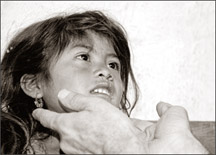|

[email protected]
Myths surrounding miscarriages?
by Dr.Vijith Vidyavibushana, Consultant Obstetrician
and Gynaecologist, Colombo South Teaching Hospital, Kalubowila.
Miscarriage is a loss of a pregnancy (after confirmation following a
urine test) before first 23 weeks or if gestation is not known, birth
weight of lost foetus being less than 500 grams.
 Why 23 weeks? That is the edge of viability. i.e. before that the
foetus is not viable or cannot survive if born, with or without medical
help. A loss after this time is called a stillbirth. Most occur before
12 weeks of pregnancy, but some occur later. Why 23 weeks? That is the edge of viability. i.e. before that the
foetus is not viable or cannot survive if born, with or without medical
help. A loss after this time is called a stillbirth. Most occur before
12 weeks of pregnancy, but some occur later.
How common is this?
It is said to be around 15 - 20 per cent i.e. among 100 pregnant
women 15 to 20 would have miscarriages. This is the incidence after
confirmation of pregnancy. But the incidence of it before a pregnancy
test (Usually the pregnancy test is done after missing a period and at
that time the embryo is usually about 2 weeks old) may be around 50 per
cent according to research.
This is because in many cases a very early pregnancy ends before you
miss a period, and before you are aware that you are pregnant.
What are the causes?
Most occur spontaneously as 'nature's selection. Most of these
foetuses are found to have some abnormality in their chromosomes arising
by chance during cell division. Usually there are no abnormalities in
parents in these cases. i.e. - It is thought that most early
miscarriages are caused by a 'one-off' chromosome fault. This is usually
an isolated genetic mistake, and rarely occurs again.
There are other less common causes of miscarriage including hormonal
imbalance, abnormalities of the womb, weakness of the cervix, certain
infections such as listeria and rubella.
Investigations into the cause of a miscarriage are not usually
carried out unless you have three or more miscarriages in a row. This is
because most women who miscarry will not miscarry again. Even two
miscarriages are more likely to be due to chance than to some underlying
cause.
If it happens once or twice, usually there is no specific cause it.
But if this happens consecutively three times or more, one has to
investigate to find the cause as there can be a cause.
Some wrong ideas about the cause of miscarriage
After a miscarriage, it is common to feel guilty and to blame the
miscarriage on something you have done or failed to do.
This is almost always not the case. In particular, miscarriage is not
caused by lifting, travelling in bus, on motor bicycle, straining or
working, constipation or straining at the toilet, stress or worry, sex,
eating spicy foods such as pineapple, papaw, or by doing normal
exercise. There are many such myths about the cause of miscarriage.
What are the signs and symptoms?
Bleeding red or brown, heavy, with clots or light spotting, abdominal
pain, backache, period like pain (NB- severe abdominal pain, faintness,
slight bleeding with a positive pregnancy test can be the signs of an
ectopic pregnancy, specially in early pregnancy. If you are high risk
for ectopic pregnancy an ultrasound scan is needed to exclude that Loss
of pregnancy symptoms (i.e.-feeling sick etc will vanish) What are the
types and possible outcomes?
Threatened miscarriage - It is common to have light vaginal bleeding
sometime in the first 12 weeks of pregnancy. This does not always mean
that you are going to miscarry.
Often the bleeding settles and the growing baby is healthy. This is
called a 'threatened' miscarriage. You do not usually have pain with a
threatened miscarriage. If the pregnancy continues, there is no harm
done to the baby.
In some cases, a threatened miscarriage progresses to a miscarriage.
If the heartbeat is seen in the scan, there is more than 98 per cent
chance of an uneventful pregnancy.
Delayed miscarriage (early fetal demise, missed miscarriage, silent
miscarriage) - In some cases there are no symptoms and sometimes there
may be very minimal symptoms. The baby dies, but remains in the womb.
You may have no pain or bleeding. Sometimes there may be a slight
brown colour discharge. This may not be found until you have a routine
ultrasound scan. Ultrasound can demonstrate heart beat in 95 per cent of
pregnancies at six weeks when the embryo (the growing baby) is as small
as five millimetres!. Therefore a competent doctor can make this
diagnosis without repeating after a week.
Incomplete miscarriage - The usual symptoms are vaginal bleeding and
lower abdominal cramps. You then pass some 'tissue' from the vagina. In
many cases, the bleeding then gradually settles. The time it takes for
bleeding to settle varies.
It is usually a few days, but can last two weeks or more. In most
cases, the bleeding is heavy with clots, but not severe - more like a
heavy period. However, it can be severe in some cases. In these cases
there will be some pregnancy tissue left inside the womb and therefore
is called an incomplete miscarriage.
Complete miscarriage - Symptoms may be similar to an incomplete
miscarriage, but bleeding settles, neck of the womb closes and an
ultrasound scan will show an empty cavity of the womb.
Do I need to go to hospital?
You should always report any bleeding in pregnancy to your doctor. It
is important to get the correct diagnosis as miscarriage is not the only
cause of vaginal bleeding. If you bleed heavily with clots, go to the
hospital immediately.
Most women with bleeding in early pregnancy are seen by a doctor who
specialises in pregnancy. It is usual to have an ultrasound scan. This
helps to determine whether the bleeding is due to
* A 'threatened' miscarriage, (the baby will be seen to be alive).
* A miscarriage.
* Some other cause of bleeding (such as an ectopic pregnancy or
bleeding from the neck of the womb).
What do the doctors do when I go to the hospital?
Complete history will be gone through before the examination. A
general examination will be done to see if you are pale, Blood pressure
will be checked, the abdomen will be examined and finally a speculum (an
instrument inserted through the vagina to visualize the neck of the
womb) examination may be done.
Speculum examination is usually uncomfortable but not painful and
will not harm the pregnancy in any way. Speculum examination may be done
after or before an ultrasound scan. Your blood group and haemoglobin
level will also be checked.
How is the diagnosis made?
With the history, examination and an ultrasound scan usually a
diagnosis can be made. For most patients an ultrasound scan is needed
unless one can see pregnancy tissue in the neck of the womb during the
speculum examination. Occasionally a repeat ultrasound scan will have to
be done to arrive at a diagnosis.
Do I need any treatment?
Once the cause of bleeding is known, and the type of miscarriage is
confirmed, your doctor will advise on options you have.
If it is a threatened miscarriage there is more than 98 per cent
chance of a good outcome to have a normal pregnancy and a healthy baby.
According to research bed rest will not improve the outcome. Some
doctors give a medication orally or as an injection and it contains a
hormone called Progesterone.
But there is no scientific evidence to suggest that it is effective
and therefore one should not regret of not having this hormone injection
as it is not proven to prevent a miscarriage.
For many years it was common to do a small operation (Surgical
management) to 'clear the uterus' (commonly called in our country as a
'womb wash' and the correct word is evacuation or D & E) following a
missed miscarriage or partial (incomplete) miscarriage and this is done
under general anaesthesia.
The logic was that this would make sure all pregnancy tissue was
gone, and may prevent infection or prolonged bleeding. However, if
ultrasound reveals no or very minimal tissue, an evacuation is not
needed as it is a complete miscarriage.
Many women in developed countries now opt to 'let nature take its
course'. In most cases the pregnancy tissue is passed out naturally and
the bleeding will stop within a few days. It is called expectant
management. An operation to 'clear the uterus' can still be an option if
the bleeding does not stop within a few days, or if bleeding is severe.
The other option is to have some medication to make the womb contract
and expel the products which is called 'medical management of
miscarriage'. Unfortunately we do not have this medication, as the
termination of pregnancy in not legal in our country. The advantages in
this method are its quick nature as, it does not involve any anaesthesia
and therefore has minimal side effects.
How long can I have bleeding or discharge
After a miscarriage usually one can bleed for a week or two and
occasionally for about for weeks. If the discharge or bleeding is
increasing or if it is smelly or if you have fever and lower abdominal
pain you should contact your doctor. Those may be a signs and symptoms
of infection which is not common.
When can I plan a pregnancy again?
It is up to you and your husband. There is no hard and fast rule -not
to get conceived for 3-6 months. Some consider a miscarriage as a loss
to their family and need some time before planning a pregnancy again.
But they should understand that after a miscarriage, an ovulation can
take place at any time and one can become pregnant even before missing a
period. If you are planning for a pregnancy soon, it is always better to
wait until you have your first period after miscarriage so that you can
date the pregnancy.
When can I have sex again?
Usually when the discharge or bleeding stops. Otherwise it can give
rise to infection.
If you are not planning a pregnancy very soon, it is always necessary
that you use a reliable method of contraception as you can get pregnant
even before missing a period. Feelings
It is only a couple who have had a miscarriage who feel how
distressing it is. Although some take it lightly, feelings of shock,
grief, depression, guilt, loss, and anger are common among these
couples.
It is best not to 'bottle up' feelings. Talking and discussing with
your husband, friends, or with a doctor or midwife, or with someone who
can listen and understand will help them.
As time goes on, the sense of loss usually becomes less. However, the
time this takes, varies greatly. Pangs of grief sometimes recur 'out of
the blue'. The time when the baby was due to be born may be particularly
sad especially if it is a late miscarriage after 12 weeks.
'Childhood cancers can be cured'
by Rosanne Koelmeyer Anderson
 'Cancers in children are unique, with a different spectrum of
pathologies compared with those of adults, but childhood cancers are now
curable. Compared with adults; children have a much lower chance of
contracting cancer. 'Cancers in children are unique, with a different spectrum of
pathologies compared with those of adults, but childhood cancers are now
curable. Compared with adults; children have a much lower chance of
contracting cancer.
Approximately, one in every 500 children will develop cancer during
their childhood. Leukaemias and lymphomas account for more than 40
percent of childhood but the survival rate of children with cancer is
almost 90 percent if timely diagnosed and advanced therapeutics is
administrated, Dr. Anslem Lee, consultant paediatrics Haematologist
Oncologist, Children's Haematology and Cancer Centre (CHCC) East Shore
Hospital, Singapore explained addressing the Annual Scientific Session
of the Sri Lanka College of Oncologists, in Colombo last week. Dr. Lee
was in Sri Lanka to address the Sri Lanka College of Oncologists on the
new trends in childhood cancer under the banner cures - the changing
prognosis of childhood cancers.'
The medical sessions also included a comprehensive presentation on
childhood cancers at the Lady Ridgeway Hospital, Borella.
It was revealed that the rate of children diagnosed with cancer is on
the increase but with advanced therapeutics and timely diagnosis
childhood cancers are curable.
The medical sessions was an insight and an opportunity for Sri Lankan
oncologists to learn more about numerous childhood cancer related
diseases such as leukaemias, Retinoblastoma, cancer of the eyeball,
lymphomas and Hepatocellutar carcinoma which is relatively frequent in
Asian regions where Hepatitis B infection is prevalent.
Children with down syndrome too are hundred times more vulnerable to
get leukaemia taking the cancer risk as high as 60-70 per cent, thus,
casting a heavy social responsibility on the family physicians and
paediatricians, in the battle against cancer.
The diagnosis of cancer in the past Dr. Lee stated used to be a death
sentence but today two out of three children newly diagnosed will now
survive the disease with improvements in surgery, chemotherapy and
radiotherapy.
'The answer as to why children get cancers is still not resolved for
most cancers but cancers in children may be genetically related,
chromosomal aberrations, immune deficiencies due to infections like
Hepatitis B virus and human immonodefficiency virus infections,
radiation mishaps or immunosuppressive treatments.
There is no evidence however to associate a mother's diet during
pregnancy, vitamin K infection given to newborn infants, vaccinations or
electromagnetic fields, Dr. Lee observed.
Investigations are needed to conform a diagnosis and classify the
cancer type and define the extent of the disease.
Some children, it was revealed may even need a bone marrow biopsy
too, and children need much supportive care to start cancer treatments,
he explained.
[email protected]
***
What are the cancers that affect children?
* Acute lymphoblastic leukaemia (ALL), is the commonest type of
cancer seen in children. The affected child may show signs of fever,
bruises, tiring easily and enlargement of glands in the neck. About
75-80 per cent of children can be cured after treatment.
* Acute myeloid leukaemia (AML) with similar symptoms where children
need chemotherapy only. The cure rate after treatment being 45-60 per
cent.
* Non-Hodgkin lymphoma (NHL), a cancer of the lymphatic glands. The
child may develop fever, tiring and enlargement of the glands in the
neck and inside the chest. Some children may complain of difficulty in
breathing or abdominal pain. Over 80 per cent of children can be cured
with chemotherapy alone. Only a small proportion of children will need
surgery or radiation treatment.
* Brain tumors, the commonest form of solid cancer in children where
children may complain of headache, vision problems, vomiting, weakness
on one side of the body, unsteadiness in walking and epilepsy.
* Germ cell tumours, inside the brain, commonly seen in oriental
children with a 60-70 per cent cure rate with chemotherapy and radiation
without complicated surgery.
* Neuroblastoma, cancer in the adrenal glands inside the abdomen
where the affected child may have fever and aches in the bones. If
detected early cure rates are 90 per cent but if in an advanced stage
treatment with surgery and chemotherapy followed by stem cell
transplantation is needed and survival rates will be only 10-30 per
cent.
* Wilms tumour, a cancer in the kidney where children show signs of
distention of the abdomen. The standard treatment is surgery,
chemotherapy and radiation with 80-90 per cent cure rates.
* Rhabdomyosarcoma, a cancer of the muscles, commonly present as a
mass where any part of the body may be affected. If the disease hasn't
spread cure rates are 70-80 per cent.
* Osteosarcoma, a cancer of the bones present with the swelling in
the thigh or leg bones. Survival rate is 60-70 per cent with surgery,
chemotherapy and radiation.
* Hepatoblastoma, a cancer of the liver, has a 90 per cent survival
rate.
* Retinoblastoma, a caner of the eyeball is very common in children.
If parents notice a white reflex in the affected eye especially when the
child's face is photographed surgery or cryosurgery is available and
survival rate is well above 90 per cent unless the disease has spread
beyond the eyeball. |
